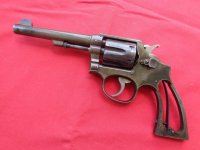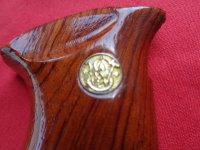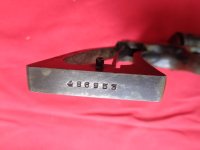mrchuck
Member
Found an old S&W revolver on a table and bought it.
It is tight, no play, and am sure it is perfectly safe to shoot standard load 38 Special 158 grain cartridges.
I saw the old style ejector rod on it first.
My catalog in my brain said ask to pick it up and check it out.
The S/N on the heel is 486953.
The cylinder has the same 486953.
The # on the inside crane holding the cylinder is 38579.
The barrel is 5 inches long. yes 5" and is pinned.
The lands and grooves are clean and sharp!
On the right side of the bbl is stamped 38 S&W SPECIAL CTG.
The grips are S&W Target in excellent shape.
A little dickering, and I paid 250 Dollars.
Yes 250 I paid. Asking for 295.
I also knew just who used to own this revolver.
I was one of our old County Sheriff's who retired back in the late 1970's.
So, back at my table I did a little research in my info book we all have, and this is what I think I have.
It is a .38 Military & Police, between 1915 to 1942, an the S/N 241704 to 1,000,000.
This revolver's s/n is almost in the middle of this range.
Their is a # stamped on the backside of the cyl and it is 38579.
Also, this same # is stamped on the inside of the swing-out frame,,38579.
On the cartridge side of the cylinder is # 486953, the same as on the butt.
Overall, this revolver shows a lot of in holster carry wear-off of the bluing.
But the mechanical part is tight and smooth.
The "overall" patina has a dark grey/brown color of age.
This revolver has been carried a lot as a "duty weapon", but not fired much.
This is common in Sheriff's, not the deputies.
My plan is to shoot it, of course, and then load it with the "appropriate" 6 rounds of standard lead 158 grain rounds.
I expect it will be a "tack driver"once I get the feel of the front blade sight and the rear "groove".
It is tight, no play, and am sure it is perfectly safe to shoot standard load 38 Special 158 grain cartridges.
I saw the old style ejector rod on it first.
My catalog in my brain said ask to pick it up and check it out.
The S/N on the heel is 486953.
The cylinder has the same 486953.
The # on the inside crane holding the cylinder is 38579.
The barrel is 5 inches long. yes 5" and is pinned.
The lands and grooves are clean and sharp!
On the right side of the bbl is stamped 38 S&W SPECIAL CTG.
The grips are S&W Target in excellent shape.
A little dickering, and I paid 250 Dollars.
Yes 250 I paid. Asking for 295.
I also knew just who used to own this revolver.
I was one of our old County Sheriff's who retired back in the late 1970's.
So, back at my table I did a little research in my info book we all have, and this is what I think I have.
It is a .38 Military & Police, between 1915 to 1942, an the S/N 241704 to 1,000,000.
This revolver's s/n is almost in the middle of this range.
Their is a # stamped on the backside of the cyl and it is 38579.
Also, this same # is stamped on the inside of the swing-out frame,,38579.
On the cartridge side of the cylinder is # 486953, the same as on the butt.
Overall, this revolver shows a lot of in holster carry wear-off of the bluing.
But the mechanical part is tight and smooth.
The "overall" patina has a dark grey/brown color of age.
This revolver has been carried a lot as a "duty weapon", but not fired much.
This is common in Sheriff's, not the deputies.
My plan is to shoot it, of course, and then load it with the "appropriate" 6 rounds of standard lead 158 grain rounds.
I expect it will be a "tack driver"once I get the feel of the front blade sight and the rear "groove".






